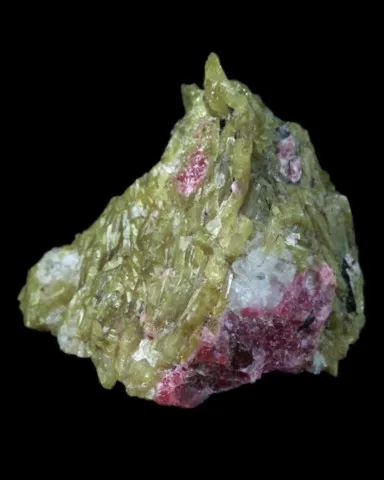MOSANDRITE
Class : Silicates
Subclass : Sorosilicates
Crystal system : Monoclinic
Chemistry : (Na,Ca,Ce)3TiSi2O7(F,OH,O)
Rarity : Rare
Mosandrite (also called rinkite or johnstrupite) is a mineral characteristic of nepheline syenites and their pegmatites, exceptionally present in their volcanic equivalents (phonolite of St-Amable, Quebec). It is a mineral with a complex formula, rich in rare earth elements (cerium, lanthanum, etc...), yttrium and titanium, all metals quite abundant in these particular rocks. It was named in honor of Carl Gustav Mosander, a Swedish mineralogist and chemist who discovered several elements of the rare earth family. Mosandrite forms elongated to acicular crystals up to 10 cm, or lamellar, frequently gathered in radiate groups, brown to red-brown in color, fading to pale greenish to yellowish through alteration.
Main photo : Mosandrite and eudialyte from the Kipawa Alkaline Massif, Quebec, Canada © Michel C. Roarke
Mosandrite in the World
Twinning
No twin known for this mineral species.
Fakes and treatments
No fakes recorded for this mineral species.
Hardness : 4 to 5
Density : 3.2 to 3.4
Fracture : Irregular to conchoidal
Streak : Pale yellow to yellow-green
TP : Translucent
RI : 1.646 to 1.658
Birefringence : 0.012
Optical character : Biaxial +
Pleochroism : None
Fluorescence : None
Solubility : Acids
Magnetism : NoneRadioactivity : Very low

